Abstract
The purpose of this study was to examine the anti-oxidative activity of pectin and other polysaccharides in order to develop a cosmeceutical base having anti-oxidative effects towards retinyl palmitate (RP). The anti-oxidative stabilizing effects of pectin and other polysaccharides on RP were evaluated by DPPH assay and then the stabilizing effect of pectin on RP was examined as a function of time. Among the polysaccharides we examined, pectin exhibited a considerably higher anti-oxidative activity, with an approximately 5-fold greater DPPH radical scavenging effect compared to other polysaccharides. The DPPH radical scavenging effect of pectin increased gradually with increasing concentrations of pectin. At two different RP concentrations, 0.01 and 0.1% in ethanol, addition of pectin improved the stability of RP in a concentration dependent manner. The stabilizing effect of pectin on RP was more effective for the lower concentration of RP (0.01%, v/v). Further, degradation of RP was reduced following the addition of pectin as measured over 8 hours. From the results obtained, it can be suggested that pectin may be a promising ingredient for cosmeceutical bases designed to stabilize RP or other pharmacological agents subject to degradation by oxidation.
Retinyl palmitate (RP) is an ester form of retinol (vitamin A) and palmitic acid. RP can be hydrolyzed to biologically active retinol after cutaneous enzymatic cleavage of the ester bond. RP is a potent anti-aging agent used for the prevention and treatment of wrinkles, and thus is widely used as a cosmeceutical ingredient of anti-aging products [1-4]. It has also been demonstrated that topical application of RP is effective in preventing UVB-induced apoptosis, erythema, and DNA photodamage [5,6].
Although RP is thermally more stable than retinol [7], its stability remains problematic, as it has been shown that RP is easily oxidized [8-11]. Thus, several methods for stabilizing RP have been suggested, including nanocapsules [12], solid lipid nanoparticles [13], microcapsules, and liposomes [9]. However, these particulate systems have several disadvantages including higher manufacturing costs, use of harsh toxic solvents, and the possibility of triggering immune response and/or allergic reactions. Furthermore, earlier efforts on stabilizing RP were focused on protecting RP from photooxidation by blocking UV light [9,12,13].
Pectin is primarily made up of a D-galacturonic acid, which is a constituent of the cell walls of most plants (Fig. 1). Pectin is derived mainly from certain types of fruits by either chemical or enzymatic processes. Pectin has the capacity to retain water and form hydrogels, and thus is widely used as gelling agent, thickener, and stabilizing agent in the food, pharmaceutical, and cosmetic industries [14, 15]. When considering the chemical structures of pectin and other polysaccharides, they are expected to exhibit anti-oxidative effects due to their numerous hydroxyl groups. If RP is stabilized by the anti-oxidative activity of pectin or other polysaccharides, various cosmetic dosage forms can be developed including hydrogels, creams, emulsions, and packs.
Therefore, the aim of the current study was to examine the anti-oxidative activity of pectin and other polysaccharides as a preliminary study for developing cosmetic products with anti-oxidative activity towards RP. The effects of the composition parameters of pectin on the degradation profiles of RP were also investigated. Moreover, the effect of pectin on the stability of RP was examined as a function of time.
Pectin from apples with a 70~75% degree of esterification was purchased from Sigma-Aldrich (St. Louis, USA). Xanthan gum, hydroxypropyl methylcellulose (HPMC), chitosan from crab shells, sodium alginate from brown algae, RP, and α,α-diphenyl-β-picrylhydrazyl (DPPH) were also purchased from Sigma-Aldrich (St. Louis, USA).
The anti-oxidative effects of pectin and other polysaccharides were evaluated using the DPPH assay described by Yamaguchi, with some modifications [16]. An aqueous solution (0.5 mg/ml) of pectin or other polysaccharides were prepared by dissolving them in water. Chitosan does not dissolve in pure water, and instead was dissolved in a solution of 1% acetate (0.5 mg/ml). A DPPH solution (0.1 ml) was mixed with 0.03 ml of the samples prepared. The mixtures were well shaken and incubated for 30 min at room temperature, and the absorbance of the solution was measured at 517 nm against a solvent (control) using an xMark microplate absorbance spectrophotometer (Bio-Rad, USA). The DPPH radical scavenging effect was calculated by the equation below.
To observe a linear relationship between the concentration and anti-oxidative effects of pectin, 0.1 ml of DPPH solution was mixed with 0.03 ml of varying concentrations of pectin, which were then analyzed as described above.
Concentrations of 0.1 v/v% and 0.01 v/v% of RP were prepared by dissolving the indicated amounts of RP in ethanol, after which 5 ml of the RP solutions were mixed with 5 ml of varying concentrations of pectin. After 5 min of vortexing, the mixtures were incubated at 40℃. Every 2 hours for a total of 8 hours, 200 µl of the samples were taken and the levels of intact RP in pectin hydrogels were analyzed at 325 nm using an xMark microplate absorbance spectrophotometer (Bio-Rad, USA).
Prior to studying the stabilizing effect of pectin on RP, the anti-oxidative activity of pectin and other polysaccharides were measured by DPPH assay, which is a widely used antioxidant assay based on the decrease in the absorbance of a radical-containing solution. DPPH is a stable free radical which has an unpaired electron at nitrogen atom and it exhibits purple color with a maximum absorption at 517 nm. When DPPH reacts with anti-oxidants, it is reduced to DPPH-H and as a result of that absorbance value decreases. Measuring the scavenging effect of anti-oxidants is based on the decrease in the absorbance of a DPPH solution according to the reaction below. In this way, the anti-oxidative activity of certain samples can be obtained by measuring DPPH radical scavenging effect.
Among the polysaccharides that we analyzed, as shown in Fig. 2, pectin exhibited considerable anti-oxidative properties, with an approximately 5-fold greater DPPH radical scavenging activity compared with the other polysaccharides. There was a statistical difference between the anti-oxidative effects of pectin and the other polysaccharides tested (p<0.05). Phenolic compounds and flavonoids are known to have anti-oxidative effects due to their abundance of hydroxyl groups having hydrogen- or electron-donating properties [17,18]. As shown in Fig. 1, pectin is primarily a polymer of α-(1-4)-linked D-galacturonic acid with hydroxyl groups at the 2' and 3' carbon atom positions [19]. Xanthan gum is a hetero polysaccharide consisting of repeated pentasaccharide units with numerous hydroxyl groups [20]. HPMC is a cellulose derivative polymer with methyl and hydroxypropyl groups, but does not contain free hydroxyl groups that can interact with DPPH free radicals [21]. Chitosan is a linear copolymer of β-(1-4)-linked D-glucosamine and N-acetyl-D-glucosamine containing one hydroxyl group for each glucosamine unit [22]. Lastly, sodium alginate is a sodium salt of alginic acid that contains two hydroxyl groups at the 2' and 3' carbon atom positions [23]. Except for HPMC, all of the polysaccharides we examined have hydroxyl groups that may produce an anti-oxidative effect, and thus similar anti-oxidative effects were expected. However, pectin exhibited a considerably higher anti-oxidative activity compared with the other polysaccharides. The reason for this may be attributed to the low viscosity of pectin compared to the other polysaccharides (data not shown). Specifically, the higher viscosity of the sample polysaccharides may have prevented appropriate interaction between the hydroxyl groups present in the polysaccharides and DPPH free radicals. Thus, hydroxyl-group containing polysaccharides may demonstrate good anti-oxidative activity when their viscosities are not overly high.
As shown in Fig. 3, the DPPH radical scavenging effect of pectin increased gradually with increasing concentrations of pectin. This result may stem from the increased density of hydroxyl groups generating the anti-oxidative effect.
Two different concentrations of RP concentrations were evaluated to determine if there were concentration-dependent effects. First, the remaining amount of RP as a function of time was determined in the absence of pectin. We found that the levels of RP greatly decreased from 100% to 39% and 61% at RP concentrations of 0.01 and 0.1%, respectively, during a 2 hour storage period at 40℃ (Fig. 4). These results implied that the degradation of RP in ethanol was dependent upon the concentration of the substrate. The reason for the greater degradation of the lower concentration of RP may have been due to the ease with which the outer environment was able to break down RP. Next, upon addition of pectin at various concentrations from 0.1~0.5 mg/ml, the stability of RP was relatively enhanced for both lower and higher concentrations of RP. Especially, addition of pectin at a lower concentration of RP (0.01% RP) significantly increased its stability at all concentrations of pectin tested (p<0.05). On the other hand, the ability of pectin to stabilize RP was drastically reduced at higher concentration of RP (0.1% RP). The reason for this result is not clear, but was consistent with our preliminary examination of the viscosities of the lower and higher RP solutions. Specifically, the lower concentration of RP was less viscous than the higher concentration RP, and thus a more effective interaction with pectin could be expected.
RP stability in ethanol and in the presence of various concentrations of pectin was monitored as a function of time (Fig. 5). The remaining amounts of RP decreased considerably for an initial 2-hour period, after which the rate of decrease slowed. As shown in Figs. 4 and 5, the stabilizing effect of pectin was greater at lower RP concentration despite the fact that the absolute levels of RP in the test solutions were greater for the more highly concentrated RP solution. We are currently performing additional experiments to clarify the mechanism behind the effect of substrate concentration on the stability of RP.
In the present study, we clearly showed that pectin exhibits a considerably stronger anti-oxidative activity compared with the other polysaccharides we examined. The anti-oxidative effects of pectin are considered to be due to the hydroxyl groups present in its structure. The anti-oxidant effects of pectin increased in a dose-dependent manner, which was likely due to the increased amount of hydroxyl groups. The stability of RP was considerably improved in the presence of pectin, because of its anti-oxidative effects and also the increased amount of pectin, which led to enhanced stabilization of RP. The stability of RP was comparatively affected by the concentration of RP itself. From the results obtained in this study, we suggest that pectin may be a promising component for cosmeceutical bases where stabilization of RP is necessary, which may prevent the need for costly stabilization techniques when RP is incorporated into cosmetic products.
ACKNOWLEDGEMENTS
This study was supported by a grant of the Korea Healthcare Technology R&D Project, Ministry of Health & Welfare, Republic of Korea (Grant No.: A103017).
References
1. Boehnlein J, Sakr A, Lichtin JL, Bronaugh RL. Characterization of esterase and alcohol dehydrogenase activity in skin. Metabolism of retinyl palmitate to retinol (vitamin A) during percutaneous absorption. Pharm Res. 1994; 11:1155–1159. PMID: 7971717.
3. Serri R, Iorizzo M. Cosmeceuticals: focus on topical retinoids in photoaging. Clin Dermatol. 2008; 26:633–635. PMID: 18940544.

4. Guenin EP, Zatz JL. Skin permeation of retinyl palmitate from vescicles. J Soc Cosmet Chem. 1995; 46:261–270.
5. Sorg O, Tran C, Carraux P, Grand D, Hügin A, Didierjean L, Saurat JH. Spectral properties of topical retinoids prevent DNA damage and apoptosis after acute UV-B exposure in hairless mice. Photochem Photobiol. 2005; 81:830–836. PMID: 15760277.

6. Antille C, Tran C, Sorg O, Carraux P, Didierjean L, Saurat JH. Vitamin A exerts a photoprotective action in skin by absorbing ultraviolet B radiation. J Invest Dermatol. 2003; 121:1163–1167. PMID: 14708621.

7. Idson B. Vitamins in cosmetics, an update I. overview and vitamin A. Drug Cosmet Ind. 1990; 146:26–91.
8. Ihara H, Hashizume N, Hirase N, Suzue R. Esterification makes retinol more labile to photolysis. J Nutr Sci Vitaminol (Tokyo). 1999; 45:353–358. PMID: 10524354.

9. Carlotti ME, Rossatto V, Gallarate M, Trotta M, Debernardi F. Vitamin A palmitate photostability and stability over time. J Cosmet Sci. 2004; 55:233–252. PMID: 15264052.

10. Carlotti ME, Rossatto V, Gallarate M. Vitamin A and vitamin A palmitate stability over time and under UVA and UVB radiation. Int J Pharm. 2002; 240:85–94. PMID: 12062504.

11. Ihara H, Hashizume N, Hirase N, Suzue R. Esterification makes retinol more labile to photolysis. J Nutr Sci Vitaminol (Tokyo). 1999; 45:353–358. PMID: 10524354.

12. Sane A, Limtrakul J. Formation of retinyl palmitate-loaded poly(l-lactide) nanoparticles using rapid expansion of supercritical solutions into liquid solvents (RESOLV). J Supercrit Fluid. 2009; 51:230–237.

13. Carlotti ME, Rossatto V, Gallarate M, Trotta M, Debernardi F. Vitamin A palmitate photostability and stability over time. J Cosmet Sci. 2004; 55:233–252. PMID: 15264052.

14. Maxwell EG, Belshaw NJ, Waldron KW, Morris VJ. Pectin -An emerging new bioactive food polysaccharide. Trends Food Sci Tech. 2011; 24:64–73.
15. Wong TW, Colombo G, Sonvico F. Pectin matrix as oral drug delivery vehicle for colon cancer treatment. AAPS PharmSciTech. 2011; 12:201–214. PMID: 21194013.

16. Yamaguchi T, Takamura H, Matoba T, Terao J. HPLC method for evaluation of the free radical-scavenging activity of foods by using 1,1-diphenyl-2-picrylhydrazyl. Biosci Biotechnol Biochem. 1998; 62:1201–1204. PMID: 9692204.

17. Rice Evans CA, Miller NJ, Paganga G. Antioxidant properties of phenolic compounds. Trends Plant Sci. 1997; 2:152–159.
18. Rice-Evans CA, Miller NJ, Paganga G. Structure-antioxidant activity relationships of flavonoids and phenolic acids. Free Radic Biol Med. 1996; 20:933–956. PMID: 8743980.

19. Denès JM, Baron A, Renard CM, Péan C, Drilleau JF. Different action patterns for apple pectin methylesterase at pH 7.0 and 4.5. Carbohydr Res. 2000; 327:385–393. PMID: 10990023.

20. García-Ochoa F, Santos VE, Casas JA, Gómez E. Xanthangum: production, recovery, and properties. Biotechnol Adv. 2000; 18:549–579. PMID: 14538095.
21. Fatimi A, Tassin JF, Quillard S, Axelos MA, Weiss P. The rheological properties of silated hydroxypropylmethylcellulose tissue engineering matrices. Biomaterials. 2008; 29:533–543. PMID: 17996292.

22. Shin-ya Y, Lee M, Hinode H, Kajiuchi T. Effects of N-acetylation degree on N-acetylated chitosan hydrolysis with commercially available and modified pectinases. Biochem Eng J. 2001; 7:85–88. PMID: 11150799.

23. Becker TA, Kipke DR, Brandon T. Calcium alginate gel: a biocompatible and mechanically stable polymer for endovascular embolization. J Biomed Mater Res. 2001; 54:76–86. PMID: 11077405.

Fig. 1
Chemical structures of the repeating units of pectin (A), xanthan gum (B), HPMC (C), chitosan (D), and sodium alginate (E).
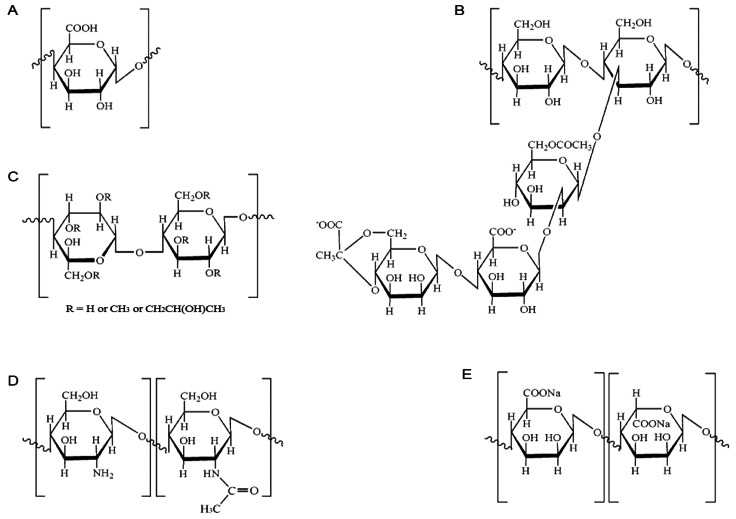
Fig. 2
Scavenging effects of various polysaccharides at a concentration of 0.5 mg/ml. Asterisks (*) indicate a significant difference (p<0.05) from the other formulations. Data are presented as the mean±SD (n=3).
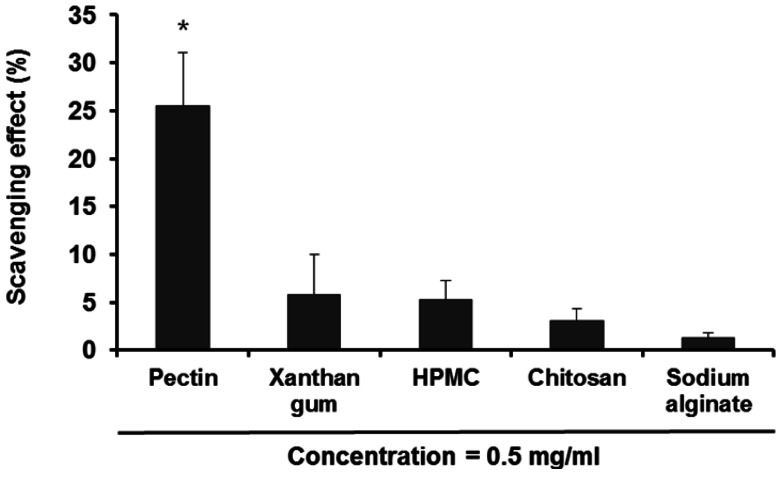
Fig. 3
Anti-oxidative activities exhibited by pectin as a function of concentration. Data are presented as the mean±SD (n=3).
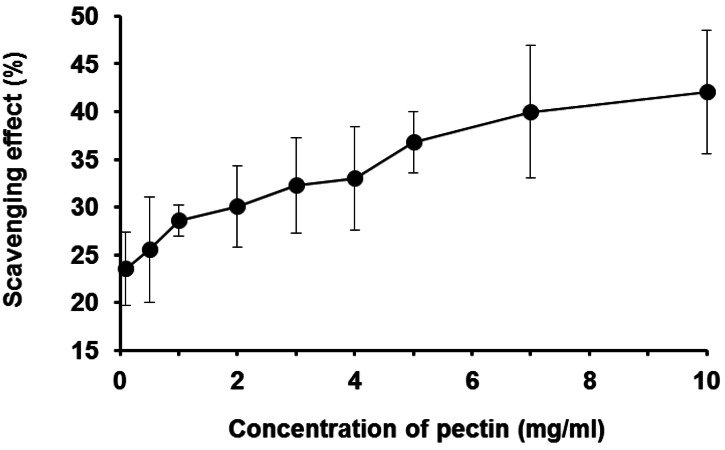




 PDF
PDF ePub
ePub Citation
Citation Print
Print



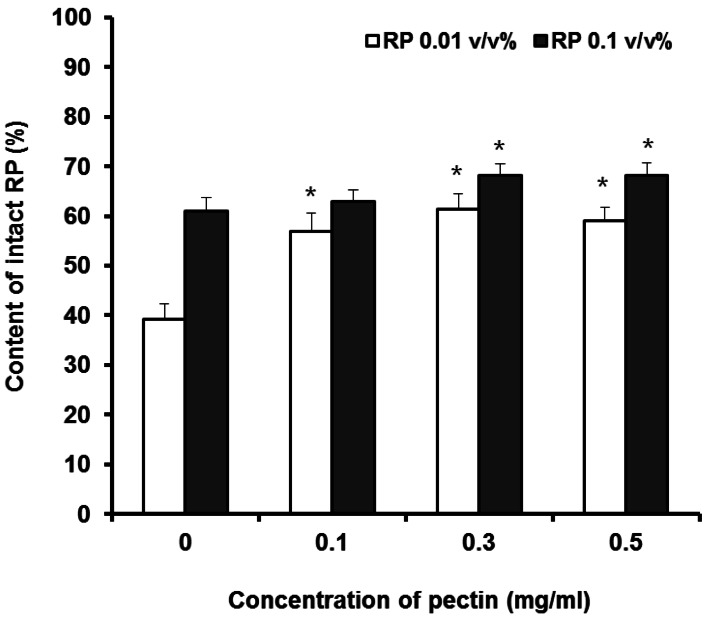
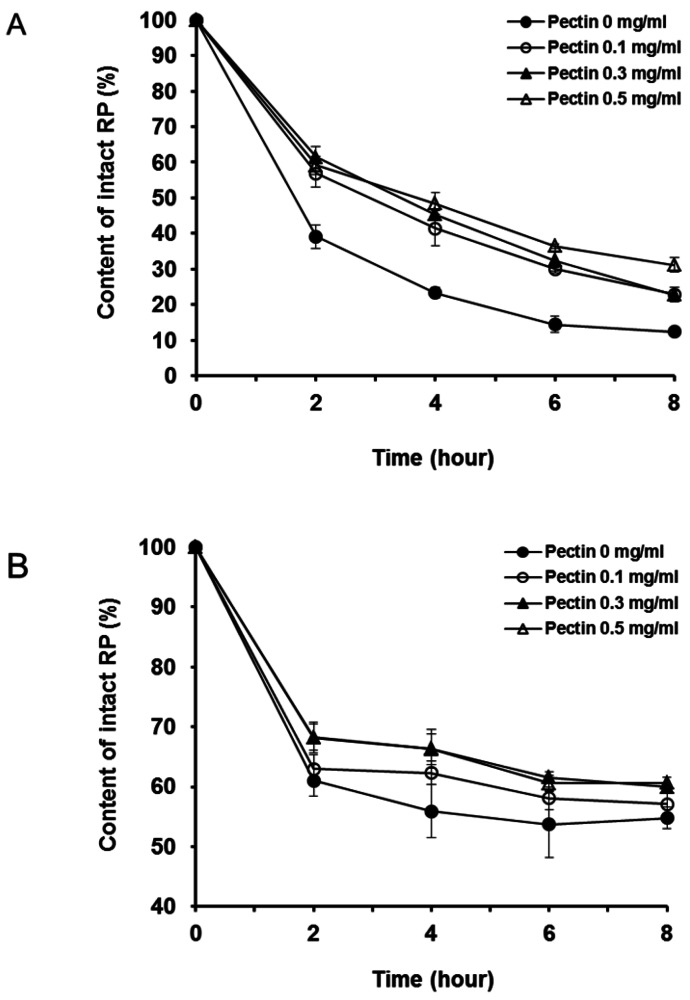
 XML Download
XML Download